How Many Japanese Families Use the Wild Orange as a Crest
Have you ever walked upward to an omamori (お守り) booth at a shrine bustling with visitors, merely to be overwhelmed while others make their purchases knowingly without batting an eye? Yous're non solitary—this guide was created after having spent months hovering around omamori booths, frantically scrolling through dictionaries and online guides that would tell me which amulets I should consider, and which ones would be inconsequential for my recreational purposes.
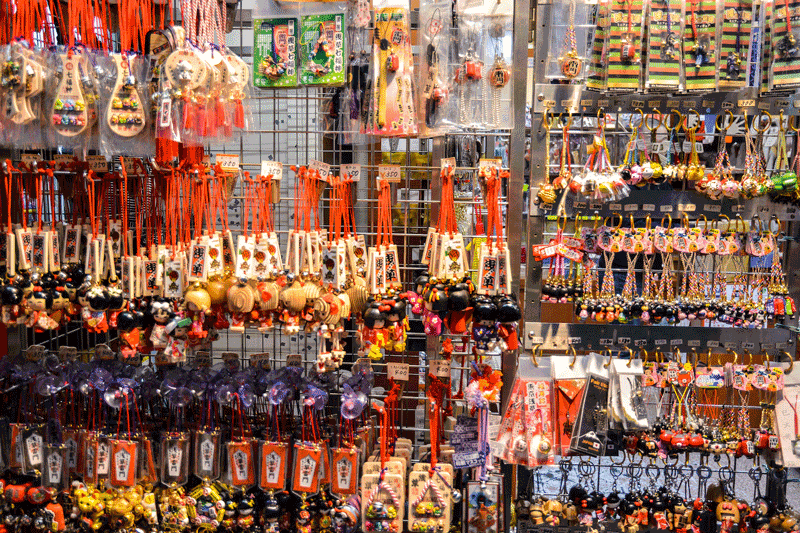
All over Nihon, each shrine and temple yous may drop in on sells small-scale omamori—loosely translated, the discussion means amulet (as a form of protection) or talisman (as a provider of luck), and the kanji at the eye of the word means "to guide or protect." They are meant to exist put on or in your phone, purse, wallet, home wall, pocket, or the like. Whether you believe their efficacy may be due to a placebo outcome or a higher power'south blessing, they are fiercely popular—especially during the New Year holidays and testing season for students.
Omamori grew to exist popular under both Shintoism (神道) and Buddhism (仏教 "bukkyou") in Japan. Priests thought putting the power and strength of the gods into small pocket-size blessings would keep people safe and motivated. Initially, their main purpose was to keep away evil spirits, and to protect patrons from bad experiences. Over time, they developed hundreds of kinds of omamori; today, we accept a wide choice of hand-made, delightfully colorful charms to choose from.
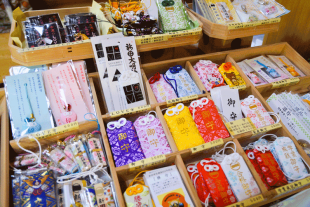
At that place is little distinguishable deviation between Shinto and Buddhist omamori: Both contain a small prayer inside, are covered in a silky material, are stamped with the site'south name, and hang by a frail thread. Omamori etiquette also follows its ain codes. Never, ever open the omamori, lest you should release the blessing and say 'sayonara' to all of that luck and protection you sought. Practice bear it exterior of your pocketbook (although this isn't a steadfast rule), and don't be afraid of damage. Seeing wear and tear is actually a good thing, as it shows that it took the burden for yous, and did its job of protecting you. Priests and miko (shrine maidens) will emphasize that each one has an expiration date—usually about a year afterwards, or until its purpose has been fulfilled. Once they do "expire," return them to the shrine or temple y'all bought information technology from, and they'll dispose of it in a sacred fire with others. (That's also your take a chance to pick upwards a fresh one for a fresh new year's day.)
The experience of searching for and acquiring your ain omamori doesn't accept to be baffling; in fact, information technology can be quite a rewarding run a risk. In that location are 1866 shrines and 2868 temples in the Tokyo area alone—don't limit yourself! Each place carries "traditional" omamori, and a series characteristic to that particular shrine or temple. The perfect charm for your personal needs is out there, waiting for you.
A Few Standard Omamori You lot're Likely to See
Success Talisman – (勝守 "katsumori")
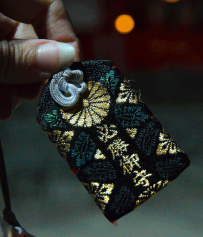
Potentially i of the virtually sought-afterward omamori, the "Success" talisman is likely to be found at about all shrines and temples. While "Success" may be vague at first glance, information technology possesses a heavy promise: the user channels their energy into a unmarried goal, and the "success" talisman guarantees it volition happen. Oftentimes, they carry the image of an arrow, which is a mutual symbol in Shintoism for aiming towards a goal. Many people opt to option one up at a spiritual ability spot. In that location are six of these famed areas beyond Tokyo, including Meiji Jingu (considered the most powerful of them all). Priests at shrines and temples urge carriers to apply each talisman for but one goal to maximize its ability.
Ward Away Evil Amulet – (厄除け "yakuyoke")
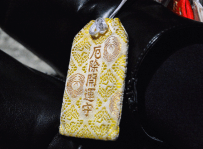
The most popular counterpart of the previous talisman, the distinction between this amulet and the Success talisman is the way in which information technology goes virtually helping you with your goal. While the success talisman actively aids 1 in their endeavors, the Ward Away Evil amulet prevents potential ills (formerly personified as demons) that might inhibit your success. Those feeling plagued by bad outcome later bad event may carry this equally a way to quell any superstitions and bring some relief.
Money Talisman – (商売繁盛 "shoubaihanjou")
Accordingly, this omamori comes in the shape of a moneybag or is draped in a gaudy yellow color—all in the intent to assistance you in the finance department. You may spot a few of these dangling from briefcases of salarymen striding through Nihonbashi. At some shrines at that place are specific money talismans for investments or savings, business deals, or personal finance. At others, there are moneybags that are geared towards luck in finding money, inheritance, or even good deals while shopping. Whether or non these talismans aid your wallet recover more quickly from online shopping splurges remains in question.
Education & Learning Talisman – (学業成就 "gakugyou-jouju")
Placing less of an emphasis on education and schooling, and more on cognition conquering, this talisman is popular amidst students. Swinging from their fundamental-chains and backpacks, students comport them throughout their school careers, using them as encouragement in their studies. This one isn't designed to assist pass any tests—at that place's a different one for that. Yushima Shrine, founded past a famous scholar once-upon-a-fourth dimension, is 1 of the best places to get: brimming with wide-eyed, hopeful students between February and March, just before the school year starts. Acting as both a beautiful emblem and a wee guardian for students makes it a fitting charm.
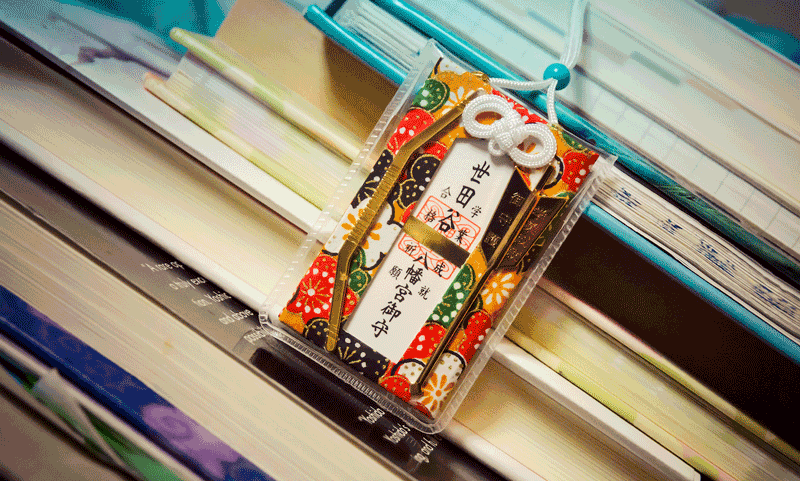
Traffic Condom Amulet – (交通安全 "koutsuanzen")
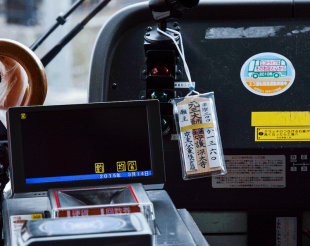
Tokyo boasts a handful of records when it comes to cities, with "most populated" and "safest," including traffic, amongst them. Though there may exist naysayers who accredit that to careful driving (although bikers and pedestrians may not corroborate), some might attribute it to their traffic safety omamori. Taxi drivers, heavy commuters, and students wishing to obtain their driver's licenses are almost certain to have 1 tucked under their steering wheel, hanging from their rearview mirror, or taped to their dashboard. Drivers frequently get them personalized and include their railroad train, omnibus number, or route on the omamori itself. It not only may serve every bit a comfort for the driver, just, perchance, as a bit of comfort for the passengers besides—especially those conducting the driving tests.
Beloved Talisman – (縁結び "enmusubi")
Love is a mutual theme amongst omamori-seekers, and just as love is complicated and no two people take the same story, these talismans for things amorous come up in several categories.
Single – If you're single, at that place's nonetheless an omamori for you. An "ordinary" omamori that bears a uncomplicated message of honey may be a skillful selection. They're intended to bring people together, to make interactions and possible relationships flourish. Don't rely on information technology to become you a partner by tomorrow—priests insist it's a "slow working" omamori, to ensure a longer and much happier relationship when the right 1 does come along.
Couples – On Saturday afternoons, somewhere in Tokyo there is a poor high school student existence dragged by their partner over towards a shrine to acquire matching omamori to solidify their relationship. Unremarkably coming in a pair, and decked in a western-style colour scheme of pink and blue, these are cute tokens that many dream of owning.
Married – The one for a young couple may come in two parts, so they may ever remember each other, but for spousal relationship, even numbers are unlucky. Because of this, omamori for marriage are ordinarily just a unit of ane, for the couple to share. They tend to be larger, with a clean white forepart bearing an image of a crane or flowers.
Childbirth – Known as "anzan," these ones help ensure a rapid and safe delivery for mothers and their babies.
Family – There are whole family sets ("kanai-anzen") likewise: they offering small reminders of boundless love between parents and children, and continue to strengthen marriage during family hardships. The ones for kids have mainstream characters stitched on them mostly, including Hello Kitty, much to the dismay of traditionalists.
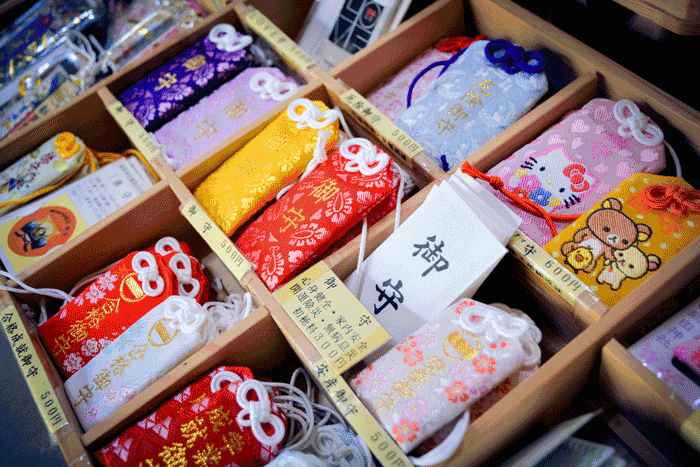
Luck-Boosting Talisman – (開運 "kaiun")
Sometimes, all you lot need is just a scrap of luck. If yous don't take a specific goal in mind, or only want a little keepsake from a shrine to remember your visit, a general Luck talisman is a safe choice. With no strings attached or specific guidelines to follow, you're costless to carry information technology around and experience secure in your conclusion-making. These tend to be bought and given every bit souvenirs and bear the name of the shrine or temple without much farther embellishment.
Happiness Amulet – (幸せ "shiawase")
Amongst all of the talismans and amulets for money, family, love, luck, and business organization, one may exist taken ashamed to see one labeled "happiness"—a concept that tin exist forgotten about until the option becomes available. Omamori accept a nuance of helping the user with methods and means to make their life ameliorate; this i whispers a small hint to, above all else, keeping yourself happy. One's own happiness may be forfeited for others, or traded for other benefits, and it serves as a nice trinket for anybody to use equally a way of taking a step dorsum every now and and so, and remembering what life is all about.
Special Omamori Along the way
Liar Bird
The proper name doesn't sound terribly positive, and the blueprint is rather unassuming compared to others, merely information technology's considered one of the rarest omamori around. Released but at Yushima Shrine on the 25th of January each year, this paw-crafted, all-wooden omamori is more than traditional than one would think. The story behind it is that the bird will have in all of your lies and secrets, and churn them out into a song of truth and guidance. Honestly speaking, the story doesn't seem very encouraging—an omamori that turns lies into truths seems more ironic than anything, peculiarly as it's sold at the virtually popular shrine for learners—but information technology's 1 of the more than powerful for didactics. Perhaps 1 more light-hearted interpretation is that it takes your misunderstandings and helps guide you towards the truth. That'southward what I'm crossing my fingers for, at to the lowest degree.
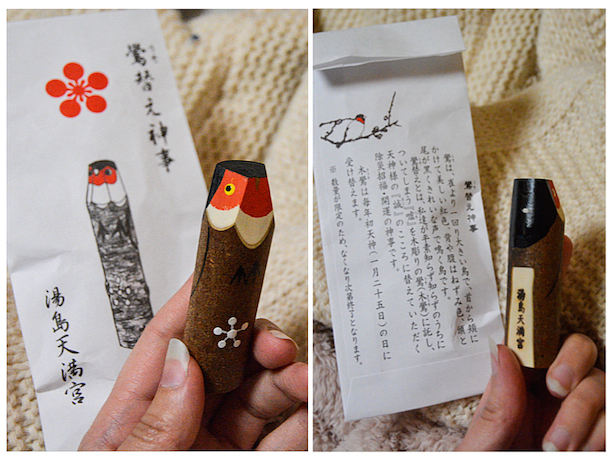
Sexual Wellness
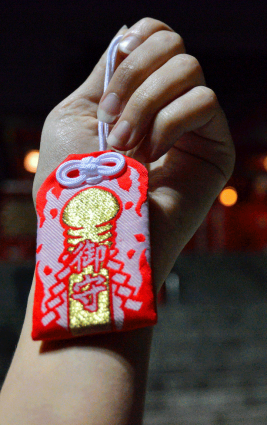
Standard health ("kenkou") omamori exist everywhere, but in that location's but one place to get an omamori made just for sexual wellness. Most people visit Kanayama Shrine in April for the ever-popular fertility festival ("Kanamara Matsuri"), but the shrine as well provides omamori and blessings for yr-circular protection and fertility boosts. Families trying for children oftentimes pray at that place. Superficially, many curious visitors may prowl effectually to look at the odd collection of phallus statues and explicit ema boards, only fundamentally, the shrines aim to provide very real protection, specially from HIV/AIDS. Donations to the shrines are ofttimes sent along to charities that support the fight against HIV/AIDS—statistics have been increasing drastically in Japan, provoking health officials to tackle the issue. The phallic omamori may seem like a prissy token of "Japan weirdness," but there is a serious, underlying purpose behind it: to shed light on and face sexual health concerns.
Dazzler of Legs, Skin, and Anti-Aging
Let's put bated whatever heated debates over 21st century beauty standards: both shrines and temples are occasionally equipped with blessings for those wishing for "beauty protection and growth." They can exist wildly general: one might provide a simple boost for "beauty" (how this is accomplished is very vague), but 1 tin can too find detailed omamori for specific areas of beautification: longer legs, better pare, anti-aging (translated directly more as "retaining youth"), leaner waist, and beautiful eyes. These amulets tend to exist more elegant, and sometimes the shrines and temples play effectually with the theme. At Kameari Katori Shrine, the beauty omamori actually has a "cinched waist," while other temples use minor sandals to represent foot or leg wellness and beauty.
Kitsune Wallet Protection
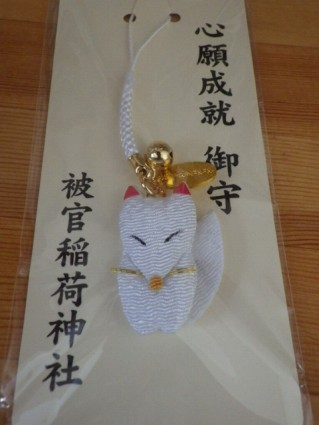
Earlier we mentioned the Money Handbag talisman to help with garnering money: this one helps safeguard what you already have. Heavy spenders may place it on their wallets as a small nudge to non accomplish equally often, while others use it to ward off thieves. The imagery falls within the "kawaii" category of all things Nippon, and, coupled with their helpful purpose, it's easy to see why these play a joke on talismans are snatched upwards.
Pet Amulets
Long ago, shrines and temples were divided between a few purposes: health, war, and agriculture. Agriculture shrines and temples were charged with helping farmers abound crops, exist on the receiving end of beneficial weather, and protect their livestock. Today, a few locations remain specifically dedicated to agriculture (including the nearby Tama Shrine in Futako Tamagawa), simply well-nigh have swapped livestock protection charms for pet charms. They come in more than unusual shapes and sizes—from paw prints to hearts to animate being tags or fauna shapes—and at some places, you lot can take the name of your pet inscribed on them. Pet-specific shrines are oftentimes visited by families toting their pets aslope them; turtles, dogs, snakes, cats, birds, rabbits, and even rhinoceros beetles tin can be found gallivanting under the archways, seeking blessings.
Sports Talisman
At Kanda Shrine, with flags for the 2020 Olympics displayed around the circumference of the grounds, you'll find a plethora of sports-themed omamori. Coming in the shape of a variety of different sport equipment, they are meant to provide a boost in agility and scores. The staff recommends buying the piece just before your season begins, and returning it for a ceremonial burning at the same shrine when the season closes out. There are also more nondescript sports omamori geared more for observers who merely want their team to win. You'll notice some national omamori for the upcoming 2020 Olympics in that location equally well. Naturally, at that place are temples built for certain sports simply—Saitama has a rather large and famous ane solely for golfers—but Kanda offers a squeamish location that challenges you to sift through the anime and artistically decorated omamori to discover the sportier ones.
Flying Protection
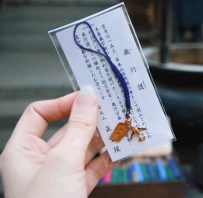
Fifteen minutes to the north of Sensoji Temple is the much, much smaller Tobifudo Shrine. Shrouded in the shadow of nearby apartment complexes, it makes for an eerily tranquillity visit. Dedicated almost entirely to flying, it'due south a shrine for those those who fear getting on airplanes, want to pray for their loved ones to arrive safely, and those who work in the industry. They have a number of impressive airplane-themed omamori, with striking colors and rich design. Not to be confused with the "travel" omamori, this omamori is intended for the plane and the flying itself. "Travel" omamori are for a vacation or for concern trip luck—those tin can be plant at Zenjoji or Zenkokuji temples. At Tobifudo, yous'll run into a wall of ema boards most the burning incense; through the fume, you lot can see specific flying numbers and routes written on the boards, with a good wish for each one. The priest is especially gentle and eager to assist visitors and discuss flying with anyone and anybody. Offer comforting tokens to have when preparing to head to the skies, at that place is something genuine and downwardly-to-earth about this shrine that helps you accept flight.
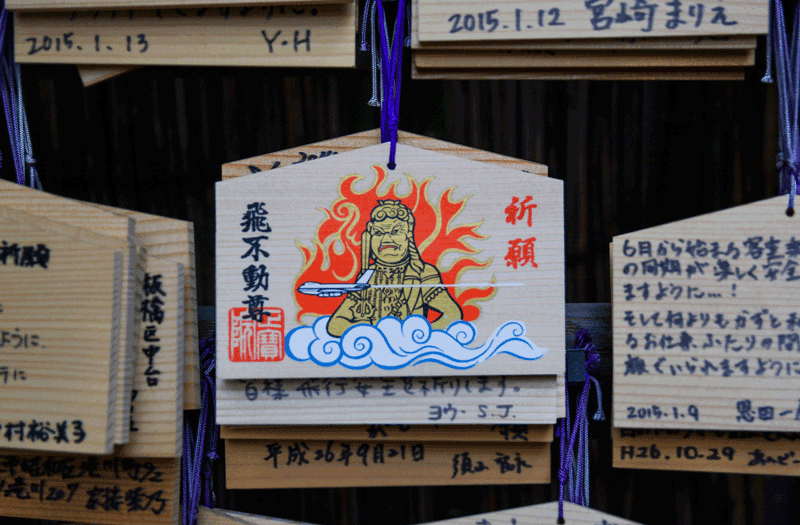
Protection for Returning Home – Octopus + Sea Edition
Using a play-on-sounds of "Ta" (significant "too much" or "many") and "Kou" ("good luck" "happiness"), the symbol of this shrine is the octopus (Takou). This is another temple that'south difficult to notice, as most searches volition yield the much-more than famous Tako Yakushi Temple in Kyoto, or its sis temple in Kamakura. The i in Meguro, Tokyo, is officially called "Jojuin Temple." It has an octopus for a symbol and is named after a sailor who fought through rough seas and returned home safely. The legs of the octopus are intended to "suck" fortune and luck and cling to information technology for you. At that place is a rather peculiar history surrounding the shrine itself, including whispers about plotted assassinations, early deaths, shogun secrets, and greedy fishermen. The statues and the grounds are said to exist of nifty significance to them, and date dorsum to 851.
Applied science Boost
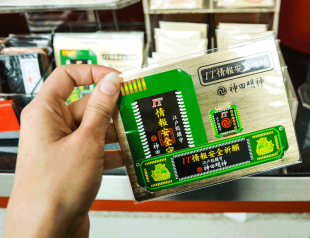
Created just over a decade agone when Japan began to actively get online, these innovations of some clever Kanda Shrine priests are meant to offer divine assist with your technology. A popular omamori to give to those who still take trouble with copying and pasting, the It-related omamori is there to help y'all fight those cyberspace ads and continue yous from relying on McAfee Antivirus software. Directions are a bit unclear on how yous're supposed to deport it—it's one of the rare omamori that doesn't come with a small strap—but looks as if information technology could sit on superlative of a figurer monitor or slide into a wallet hands. Tech-savvy users may opt out, merely it is withal a unique and modernistic show of Japanese shrines and temples tackling the small but recurrent bug of today.
Zodiac
A few shrines, Meiji Jingu, Jindaiji, and Yushima included, offer zodiac and star divination-themed pocket protectors. These more personalized zodiacs are more than powerful if bought during the starting time of their designated month of the twelvemonth, and are intended for you to return year after year to collect the new design. Simpler than other omamori, these are meant to act as general luck-boosters, and are meant to provide you with good memories and a positive alignment of the stars for you lot during your special year or month. Usually marked with the emblem of the animal on them, they're easy to spot and a nice "way out" if y'all can't make upwardly your heed virtually all of the other options.
Good Luck Cat
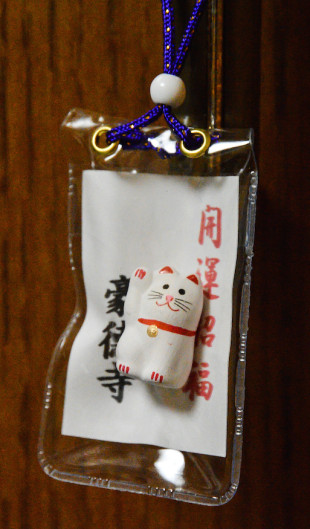
Centuries agone, a lone, hungry, defeated samurai was trudging through a dark, rainy night when he spot a gleaming white cat, poised in a doorway, mitt up, as if it were beckoning the samurai forrard. He followed, and found the habitation of a priest who furnished him with room and board for the nighttime. Today, Gotokuji Temple honors that cat. The sprawling and serene temple is beautiful in jump, and nestled in a cove backside one of its main halls is a shrine dedicated to the true cat. It'south covered in hundreds of little "lucky cat" statues, and but around the corner is a small-scale shop where you can buy the cat in an omamori course. With a tale like that, at that place may be something to it.
Monthly Heave
An culling to traditional omamori are ema boards—the pocket-sized wooden plaques hanging at shrines, covered in prayers. The ema boards at Nezu Shrine make horoscopes and zodiac keepsakes look similar kid's play. These sophisticated and gorgeous boards are hand-painted and designed for boosting luck during your birth calendar month. Each month has a unlike image of a popular flower or plant associated with that calendar month. Information technology's fun to go each month and choice up a new 1, or send them as presents for family members. They make for nice wall decorations, as it's a bit more than cumbersome to carry them effectually. Nezu Shrine alone is worth a visit even if ema boards or flowers or extra luck isn't your thing—it'south an Inari Shrine, and has hundreds of minor red tori gates you tin race through, with a moat surrounding the lush grounds. In spring, the pink copse are dazzling confronting the teal covering of the shrine architecture, with stern fox statues watching your every move.
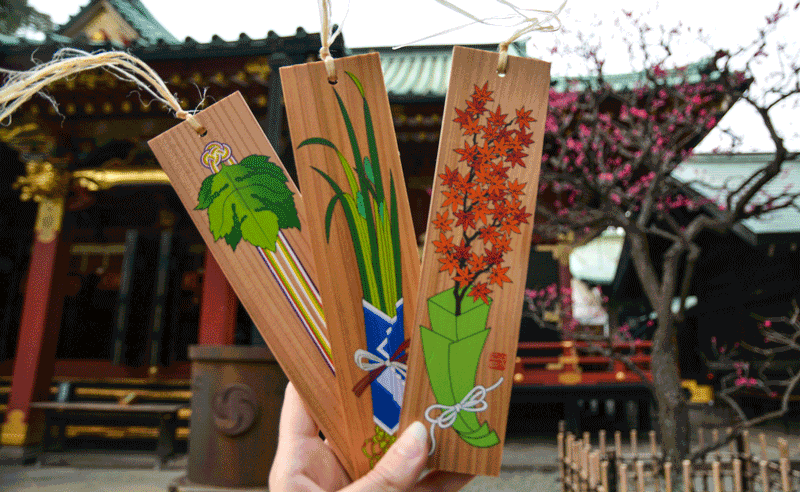
For a comprehensive list of shrines, temples, and what talisman and amulets they take, hop over to: omamorida.com. It's entirely in Japanese – Google and the Riakikun plug-in are now your best friend. Yous tin can start with the major temples and shrines, or the smallest of them all. Everyone'south journey is dissimilar, as are all of the omamori yous'll encounter while yous're on your way.
Jindai-ji, Chofu
(Traditional, Zodiac)
5-xv-1 Motomachi
Kanayama Shrine, Kanagawa
(Fertility and Health)
two-2-xiii-16 Daishi Ekimae
Nitta Shrine, Kanagawa
(Love)
one-21-23 Yaguchi, Ota
Meiji Jingu, Harajuku
(Power Spot)
one-i Yoyogikamizonocho, Shibuya
Jojuin Takoyakushi Shrine, Meguro
(Octopus, Condom Returns)
3011011 Shimomeguro
Yushima Tenman-gu Shrine, Kanda
(Instruction)
3-three-thirty-1, Bunkyo
Kanda Shrine, Kanda
(Sports, IT, Pets)
two-2-16-2- Sotokanda, Chiyoda
Nezu Shrine (and the surrounding grounds and others), Ueno
(Months)
Tobifudo, Asakusa
(Flying)
3-xi-11 Ryusen, Taito
Hikan Inari Shrine, Asakusa
(Fox, Wealth Protection)
two-iii-1 Tatio
Sensoji Temple, Asakusa
(Traditional, Marriage)
ii-three-1 Taito
Kameari Katori Shrine, Kameari
(Beauty)
3-42-24 Katsushika-ku
i-28-9 Nezu, Bunkyo
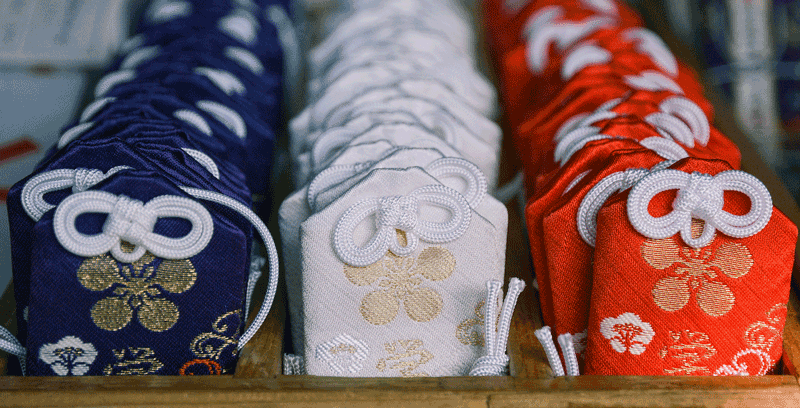
luncefordinet1986.blogspot.com
Source: https://www.tokyoweekender.com/2015/05/japanese-lucky-charms-the-guide-to-omamori/
0 Response to "How Many Japanese Families Use the Wild Orange as a Crest"
Post a Comment